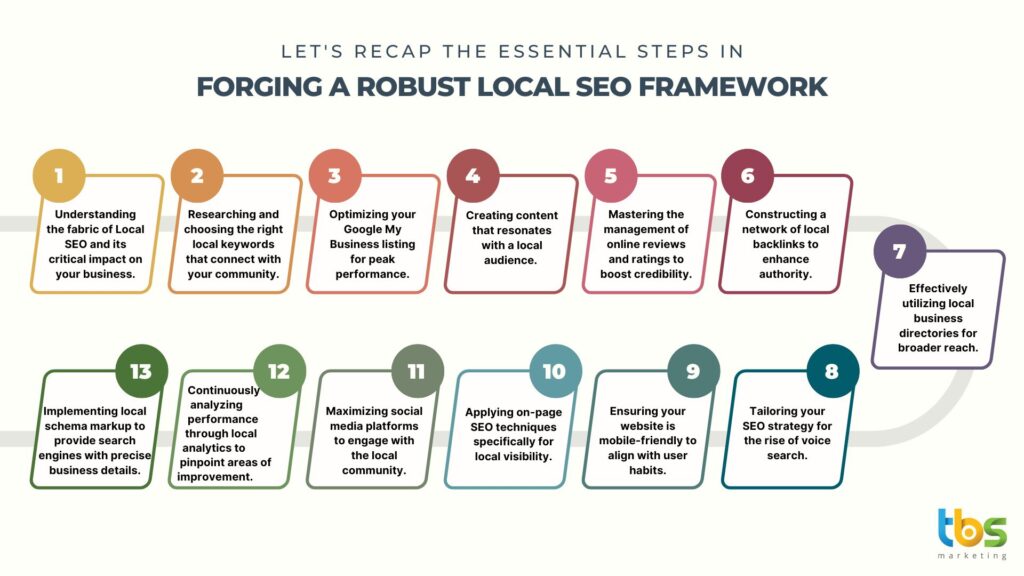
Unlike traditional SEO, which focuses on enhancing visibility on a national or global scale, Local SEO targets “near me” and geo-specific search queries to draw in a local audience. This specialized branch of SEO ensures that businesses with a brick-and-mortar presence shine online exactly where their potential customers are located.
Did you know 80% of local searches result in conversions?
Key Factors influencing Local SEO
Local search algorithms play a crucial role in how businesses are discovered through Google. Understanding the key components—relevance, distance, and prominence—can significantly impact your local SEO strategy.
Relevance: This determines how closely a Google Business Profile result matches the searcher’s query. Accurate and detailed business listings help improve relevance, making it essential for businesses to ensure their information is up-to-date and comprehensive.
Distance: This factor considers the proximity between the user and the businesses listed in search results. Google aims to deliver the most accessible locations based on the searcher’s location.
Prominence: This aspect evaluates how well-known a business is, which can be influenced by reviews, local media mentions, and overall web presence. Prominent businesses are more likely to feature prominently in search results.
Google typically displays local search results in two main formats: Google Maps and Business Profiles.
These are often shown in a “Map Pack” or “Local Pack,” which consists of a small map and a list of three businesses that match the search criteria. This pack can dominate the top of search results, making it a critical target for local SEO efforts.
How to identify relevant local search terms?
Finding the right local keywords involves a series of steps:

- Think like your customer: Start by brainstorming how your customers might search for your services online. Consider the phrases that include your location and service type.
- Research related search terms: Use Google’s autocomplete and related search features to see what other local terms are associated with your services.
- Focus on long-tail keywords: These are more specific phrases that may have less competition and higher conversion rates.
Tools and Methods to Scope Out the Local Keyword Scene
With the right tools at your disposal, you can thoroughly analyze the local keyword landscape:
- Utilize Google Keyword Planner to gauge the search volume and competition for local search terms.
- Explore Google Trends to identify local search queries that are currently popular and on the rise in your area.
- Examine your competitors’ websites with SEO tools like Moz Local or SEMrush to discover which local keywords they are targeting. If you need help , contact TBS Marketing. Our team comprehensively utilizes keyword research tools for your local business.
Pro tip: When conducting keyword research for your local business, consider both “store + city” and generic “store” keywords. Although “store” keywords might receive more general search volume, “store + city” can capture more targeted local traffic. Notably, even if users don’t include location-specific terms like “near me” in their searches, Google’s algorithms will still prioritize local results if the intent seems to be location-based.
Mastering Google Business Profile
Having a Google Business Profile is an essential tool for local businesses to increase visibility in Google’s local search results.
Follow these steps to create and optimize your GMB listing:
- Create or Claim Your Business Listing: Start by searching for your business on Google to see if a listing already exists. If it does, you can claim it. Otherwise, you can create a new one.
- Verification: Google will need to verify your business. This is typically done through a verification code sent by mail to your business address.
- Accurate Information: Ensure that your business name, address, and phone number (NAP) are consistently presented across all online listings. Your NAP should be in crawlable HTML text on your website to enhance location-based search results. For guidance on where to place your NAP on your website or if you need further assistance, feel free to contact us!
- Business Categories: Select relevant categories that precisely describe what your business offers. This helps Google show your business for the right search queries.
- Business Hours: Publish your operating hours to inform potential customers when you’re available.
- Add Photos: Upload high-quality images of your business, products, and services to attract more attention to your listing.
- Write a Compelling Description: Provide a brief but informative description of your business using relevant keywords.
- Attributes and Amenities: Include any additional features or services that might be relevant to searchers, like Wi-Fi availability, wheelchair access, or free parking.
Check out this guide for a comprehensive overview on how to set up your GMB profile: (add the attachment)
Maintaining Your GMB Listing

To keep your GMB profile optimized for local searches, consider these ongoing efforts:
- Keep Information Updated: Regularly check your listing and make updates as needed, like changes in hours, closures, or temporary services.
- Respond to Reviews: Engage with customers by responding to reviews, both positive and negative. This interaction demonstrates that you value customer feedback and are active in managing your online presence. As a result? you increase more social proofing. Its a win-win.
- Publish Posts: Use the posts feature within GMB to share updates, offers, events, and new products or services. This content can keep your listing fresh and provide more reasons for searchers to choose your business.
- Q&A Section: Monitor and answer the questions that appear in your GMB profile. This not only provides direct support to potential customers but also builds a valuable knowledge base for others.
- Track Insights: GMB offers insights that can help you understand how customers interact with your listings, such as search queries used to find your business, and how many calls or direction requests were initiated from your profile.
Remember, local searchers are often ready to act, so a robust, accurate, and active GMB profile could drastically increase the foot traffic to your business.
Maximizing Visibility with Local Business Directories
Local business directories are an invaluable asset in the realm of Local SEO. They not only provide an opportunity for your business to be discovered by a local audience but also contribute significantly to improving your search engine rankings. When your business is listed in reputable local directories, you establish a presence where potential customers are actively seeking services or products you offer.
How to Select the Right Directories for Your Business
Choosing the right directories for your business is crucial to your Local SEO success. Begin with well-known directories such as Google My Business, Yelp, and Bing Places. Then, look for local directories specific to your region or industry. Consider directories that have a high domain authority and offer an option for customer reviews, as they can boost your business’s validity and exposure.
Ensuring Consistent NAP Across Directory Listings
- Consistency is key when it comes to listing your business on various directories. Your business’s Name, Address, and Phone number (NAP) need to be exactly the same across all listings. Inconsistencies can confuse customers and negatively impact your search engine rankings. Make sure that every listing is accurate and matches the information on your website and other platforms.

- Verify your details: Regularly check your listings to ensure that all the information is current and correct.
- Update as needed: If there are changes to your business, such as a new address or phone number, update all directories promptly to maintain consistency.
- Avoid duplicates: Duplicate listings can harm your SEO efforts. If you find multiple listings for your business, try to remove or merge the duplicates.
On-Page SEO Techniques for Local Visibility
On-Page SEO is a critical component of a successful local SEO strategy. By optimizing the on-page elements of your website, you can enhance your visibility for local searches.
Optimizing Title Tags and Meta Descriptions with Local Keywords
Title tags and meta descriptions are among the first elements that potential customers notice in search engine results. Ensure your title tags include local search terms relevant to your business and service area, and make your meta descriptions concise and appealing, with a local focus to improve click-through rates.

Incorporating Local Search Terms in Headers and Content
Your headers should not only signal the structure of your content to users but also to search engines. Include local keywords in your H1, H2, and H3 tags to emphasize the local nature of your business. Similarly, weaving local search terms naturally within your paragraphs (p) boosts your relevance for local searches, but remember to keep it readable and useful for your audience.
Leveraging Location Pages
If you serve multiple locations, creating individual location pages can be immensely beneficial. Each page should contain location-specific information, including your business address, opening hours, and localized content. This not only provides a better user experience but also helps search engines understand and rank your site for searches in these areas.
Targeting Different Service Areas
To target different service areas or locations, develop content that speaks directly to the local audience of each area. Use location-based ul and li elements to highlight services, offerings, or area-specific features, such as:
- Local community events or sponsorships
- Customer testimonials from residents
- Case studies of local projects
Leveraging Local Schema Markup
The digital landscape is teeming with websites competing for visibility, and local schema markup can significantly boost your chances of standing out. Schema markup is a code added to your website that helps search engines provide more informative results for users.
Schema Markup and Its Benefits for Local SEO
Schema markup is a form of microdata that creates an enhanced description (commonly known as a rich snippet), which appears in search results. For local businesses, adding schema markup can improve local search visibility by highlighting key information such as:
- Business hours
- Contact information
- Physical address
- Ratings and reviews
These details make it easier for search engines to understand the context of your content, potentially leading to higher rankings and increased click-through rates.
Implementing Local Business Schema to Help Search Engines
Integrating local business schema tightly weaves your business information into the search ecosystem. Search engines can digest and display your business specifics in a more structured manner, directly addressing user queries with precision. Assurance that your company’s information is consistent and accurate across the web enhances trust and reliability in the eyes of both search engines and customers.
Tools and Resources for Testing and Validating Your Schema Markup
Once you’ve implemented schema markup on your website, it’s crucial to test and validate your code to ensure there are no errors. Google’s Structured Data Testing Tool and Rich Results Test are invaluable resources for this purpose, providing feedback to tweak and perfect your schema implementation for optimal performance in local search results.
Strategies to Craft Content that Resonates with Local Audiences
Localizing your content strategy involves more than just geographically-specific references. It’s about curating content that reflects the interests, issues, and needs of your local populace. This can be achieved by:
- Highlighting local success stories or case studies.
- Including interviews with local figures or businesses.
- Creating problem-solving content that addresses your local market’s pain points.

Ways to Incorporate Local Keywords, Events, and News into Your Content
Incorporating local keywords into your content is crucial, as is weaving in mentions of local events and news. This not only boosts SEO but also shows your audience that you’re in tune with the community. Consider the following:
- Use tools to identify trending local keywords and integrate them naturally into your content.
- Write blog posts or news articles about upcoming local events or recent happenings.
- Promote local industry gatherings, charity fundraisers, or educational workshops.
The Importance of Producing Content that Adds Value and Relevancy to Your Local Customer Base
Value and relevancy are the trademarks of content that engages and retains customers. For local SEO, your content should answer the questions that local customers are asking and provide solutions they can use. Here’s how:
- Conduct surveys or research to ascertain the specific needs of your local audience.
- Develop how-to guides, tutorials, and tips with a local twist.
- Feature user-generated content that showcases the local lifestyle and customer experiences.
The Significance of Local Backlinks to Local SEO Results

Backlinks from other reputable local businesses and organizations add significant value to your local SEO efforts. They help search engines recognize your site as a credible resource within your locale. Local backlinks can improve your visibility in local search results and drive more targeted traffic to your site, leading to increased foot traffic and sales.
Tactics for Acquiring Quality Local Backlinks from Reputable Sources
- Engage with local bloggers: Identify influential bloggers in your area and see if they can feature your business or contribute a guest post to their blog.
- Participate in local events: Sponsor or participate in local events, fairs, or charity drives which can result in online mentions and backlinks.
- Get listed in local directories: Ensure your business is listed in local directories with a link back to your website.
- Press releases: Send out press releases about noteworthy company news or events to local media outlets.
Techniques for Leveraging Partnerships and Community Involvement to Build Backlinks
- Form partnerships with local businesses: Reach out to complementary local businesses to cross-promote each other online.
- Join Chambers of Commerce: Membership often includes a directory listing with a backlink.
- Local sponsorships: Sponsoring local teams, events, or charities can result in a backlink from their websites.
- Encourage local clients to link to you: If you provide services to other local businesses, ask to be credited with a link on their site.
Remember, acquiring local backlinks is not just about quantity, but also about quality. Focus on earning backlinks that will genuinely improve your business’s local relevance and reputation.
TBS Marketing can assist your business by conducting thorough SEO audits and acquire high-quality backlinks. Contact us today for more link building strategies.
Optimizing for Voice Search in Local SEO

The landscape of local SEO is rapidly evolving, with voice search gaining prominence as a key player in how users find local business information. As more people use digital assistants like Siri, Alexa, and Google Assistant, the importance of optimizing for voice search is undeniable.
Understanding Voice Search Optimization
Voice search optimization means adapting your content to the conversational tone and simple language used in voice queries. People tend to use longer, more natural phrases when speaking compared to typing. Therefore, your content must reflect this natural flow to have the best chance of being picked up by voice search algorithms.
Strategies for Optimized Content
- Incorporate long-tail keywords: Target long-tail, conversational keywords that mirror how people speak in real life. These are likely to align with the queries used in voice searches.
- Focus on question-based content: Structure your content to answer the common questions potential customers might ask about your local business.
- Create local content: Provide information specific to your local area, as many voice searches are looking for services or products near them.
Structuring Information for Featured Snippets
Google’s featured snippets often feed the answers provided by voice search devices. To optimize for these, ensure you:
- Organize content in a clear, concise manner: Use bullet points, lists, and clear headings to make it easier for search engines to pull relevant information.
- Answer questions directly: Provide straightforward answers to frequently asked questions in your content.
- Enhance your local presence: Update your Google Business Profile and gather locality-specific mentions to boost local relevance.
By following these guidelines, you’ll improve your chances of being the go-to resource for voice searches specific to your local area, driving more customers to your business.
Master Mobile Optimization for Enhanced Local SEO

88% of people who conduct a local search on their phone visit within a week.
With the ever-growing prevalence of smartphones, mobile optimization has become the cornerstone of an effective local SEO strategy.
Key Elements of Mobile Optimization
- Responsive Design: Ensure your local website is accessible and user-friendly across all devices. Responsive design automatically adjusts your site’s layout to fit the screen it’s being viewed on, whether it’s a smartphone, tablet, or desktop.
- Load Speeds: A fast-loading website is imperative to keep mobile users engaged. Speed up your site by optimizing images, leveraging browser caching, and reducing server response times to improve both user experience and search engine rankings.
Improving Mobile User Experience
Conducting regular mobile user experience tests is key to retaining customers and climbing up the local search rankings.Focus on easy navigation, clear call-to-action buttons, and quick access to essential information like contact details and business hours.
Contact TBS Marketing of skilled web developers who are dedicated to enhancing your website’s performance and user experience.
Analyzing and Adapting SEO Strategy Using Local Analytics
Perfecting your Local SEO approach demands a clear understanding of the results your efforts yield. It’s essential not only to implement SEO strategies but also to analyze their effectiveness and make necessary adjustments. Local analytics serve as a goldmine of insightful data that will guide you in assessing the performance of your Local SEO initiatives with precision.
Understanding the Metrics That Matter for Local Businesses
By focusing on these, businesses can gain a true sense of how their local digital efforts are performing. Metrics such as local search rankings, conversion rates from local listings, and engagement on localized content provide actionable insights. But it’s not just about the figures; the real art lies in interpreting these metrics to understand customer behavior and local market performance.
- Local Search Rankings: Monitor your position in search results for local queries.
- Conversion Rates: Track how effectively your local listings lead to desired actions, like calls or in-store visits.
- User Engagement: Measure the interaction with your localized content to understand its relevance and impact.
While SEO might seem complex, our experts can simplify it with a free website analysis to boost your ranking.
Leveraging Social Media for Local Search Visibility

Social media can significantly boost your local search presence. By actively posting and participating in local conversations, you make your business more visible to a community-based audience. Remember, search engines like Google also index social media content, making it a significant asset for your local SEO strategy.
Don’t let your competitors dominate! Get started on your social media profile today with TBS Marketing.
Engaging the Community with Localized Posts and Ads
Creating posts and ads that resonate with your local audience can lead to higher engagement and improved local brand recognition. Use geo-targeting in your ad campaigns to reach potential customers in specific areas. Share content that appeals to local culture, events, or causes to show that your business is an active part of the community.
Integrating Social Listening for Local Trends
Social listening is the process of monitoring digital conversations to understand what’s being said about a brand or industry. By paying attention to local trends and discussions, you can uncover insights related to your service or business. Use this knowledge to tailor your offerings to meet local needs, thereby positioning your business at the center of local consumer interest.
- Monitor local hashtags and keywords to stay on top of relevant conversations.
- Engage with users who mention your business or are looking for services you offer.
- Participate in local events and campaigns, and use your social media to promote your involvement.
The future outlook of local SEO
Hyperlocal SEO: With technologies enabling precise location-based data utilization, there’s a growing focus on hyperlocal targeting. This means optimizing for extremely localized areas such as specific neighborhoods or blocks to deliver highly relevant content to the local community. This can include special offers or promotions exactly when and where potential customers need them (Local Falcon).
Leverage location-based data and technologies to identify hyperlocal opportunities. Conduct market research to understand the specific needs and interests of your target neighborhoods. Create localized content, such as blog posts, videos, or social media updates, that resonate with these micro-communities.
AI Integration in Local SEO: The integration of AI and machine learning into local rank tracking tools is set to democratize local SEO. These AI-powered tools can provide intelligent recommendations for optimizations, making local SEO more accessible and effective for businesses of all sizes (Local Falcon).
Invest in AI-powered Local SEO tools that can analyze data, identify patterns, and provide actionable insights for improving local rankings. Utilize the recommendations provided by these tools to refine your Local SEO strategy and stay ahead of the competition.
Optimization for Multiple Search Channels: As people increasingly use platforms like TikTok, Reddit, and YouTube for information, optimizing content across these and other non-traditional search methods is becoming crucial. This multi-channel optimization helps capture a broader audience and gathers more comprehensive SEO data (WebFX).
Strategies: Develop a comprehensive content strategy that includes optimization for various platforms and channels. Leverage relevant keywords, hashtags, and platform-specific features to enhance visibility and engagement. Monitor user behavior and trends across these channels to identify new opportunities for optimization.
Apple Maps Optimization: With the rise of Apple Maps usage among iOS users, optimizing for Apple Maps with tools like Apple Business Connect is becoming more relevant. Even though Google Maps dominates, increasing attention to Apple Maps could provide a competitive edge (Local Falcon)
Develop a comprehensive content strategy that includes optimization for various platforms and channels. Leverage relevant keywords, hashtags, and platform-specific features to enhance visibility and engagement. Monitor user behavior and trends across these channels to identify new opportunities for optimization.
Video SEO: The surge in video content consumption is significant, with a strong push towards creating video content optimized for SEO. This includes using targeted keywords in video titles, descriptions, and ensuring your video content is accessible and engaging to boost visibility and engagement (Semrush)
Develop a comprehensive content strategy that includes optimization for various platforms and channels. Leverage relevant keywords, hashtags, and platform-specific features to enhance visibility and engagement. Monitor user behavior and trends across these channels to identify new opportunities for optimization.
E-E-A-T (Experience, Expertise, Authoritativeness, and Trustworthiness): Demonstrating E-E-A-T is critical. This involves creating user-focused, helpful content that signals expertise and trustworthiness, which is essential for attracting high-quality backlinks and improving search rankings (WebFX).
Develop a comprehensive content strategy that includes optimization for various platforms and channels. Leverage relevant keywords, hashtags, and platform-specific features to enhance visibility and engagement. Monitor user behavior and trends across these channels to identify new opportunities for optimization.
Your strategy should evolve with your business and the competitive local landscape. Utilizing data-driven decisions, you can adapt your efforts to align with local market trends and emerging opportunities. This responsive and proactive approach allows you to stay ahead in the local SEO game, offering the best possible outcomes for your online visibility and drive traffic to your physical location.

In conclusion, an effective Local SEO strategy is much like a living organism; it grows, adapts, and requires care to thrive. By staying abreast of changes and refinements in SEO practices, and understanding how customer interactions shift, your business can not only stay relevant but also excel in attracting local customers. Commit to regular check-ins with your strategy, tweak as necessary, and keep your business at the forefront of the local search landscape.
